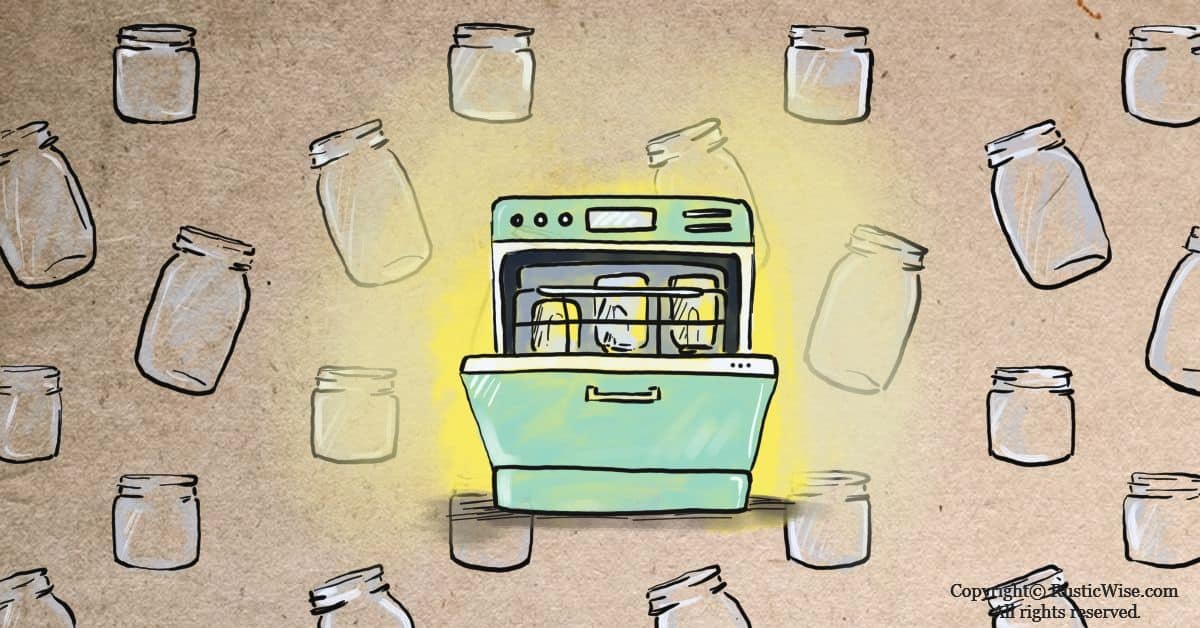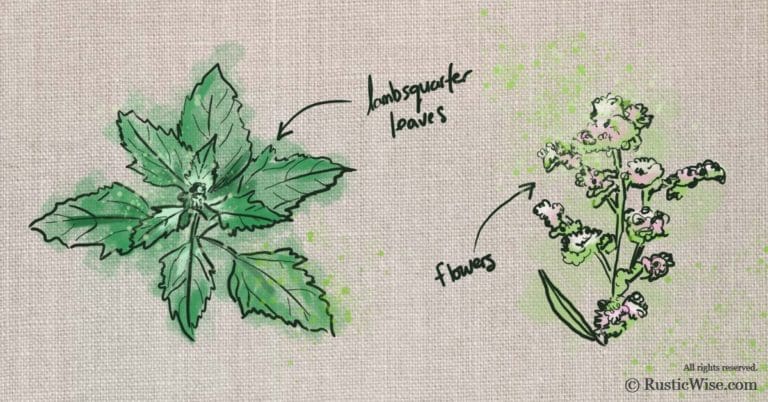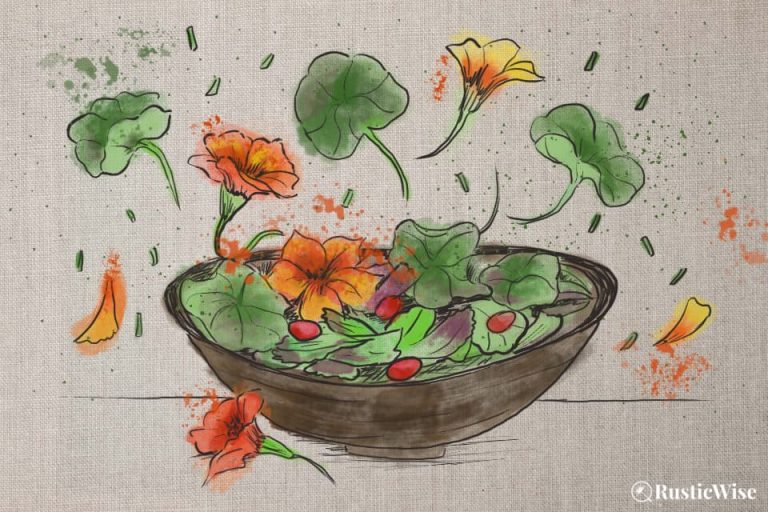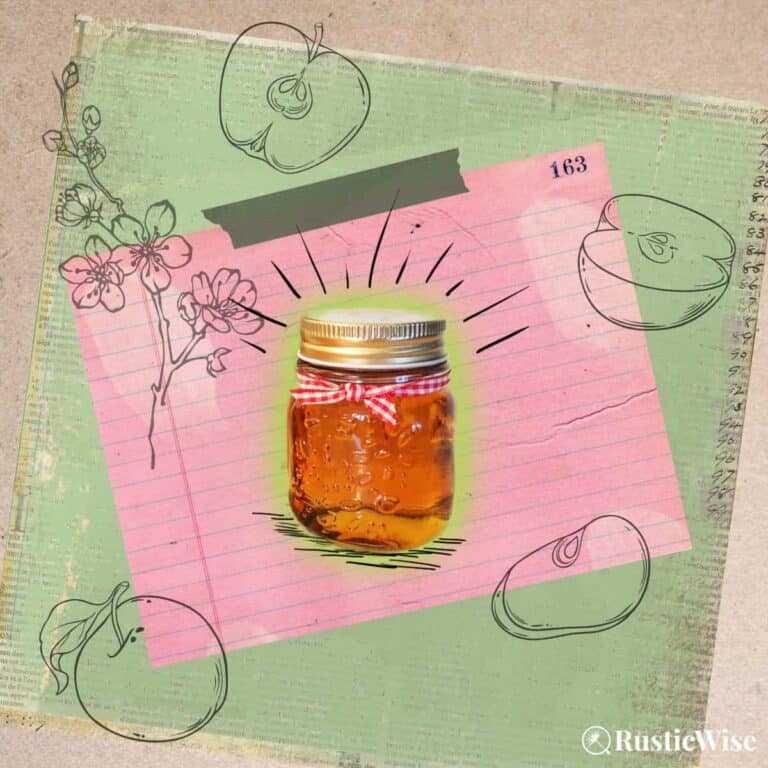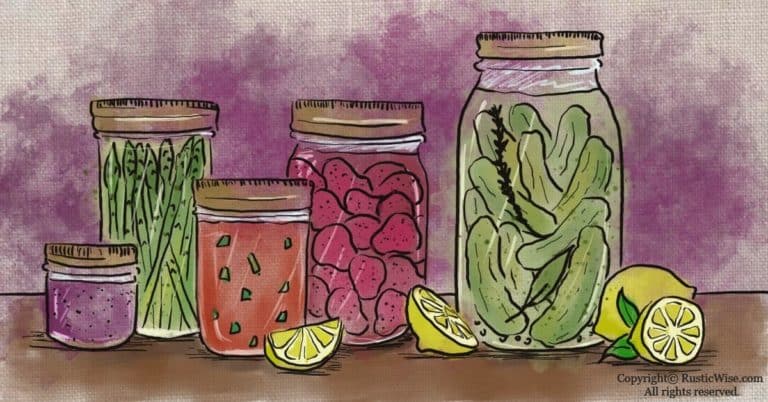Can You Sterilize Canning Jars in the Dishwasher?
Sterilizing your canning jars is one way to ensure they’re clean and safe for use. There’s much confusion about sterilization best practices. Can you sterilize canning jars in the dishwasher? Best practices for home canning state that to safely sterilize jars, you need to submerge them in boiling water. We’ll explore whether it’s safe to put glass canning jars in a dishwasher. We’ll also talk about the difference between sanitizing and sterilizing, when you should sterilize your jars before using them, and when you can safely skip this step.
Canning jars are made of glass, and it’s important to keep them clean and free of harmful bacteria before using them for home canning. If you’re new to home canning, then this article might be helpful for understanding best practices and safety precautions.
What’s the difference between sterilizing and sanitizing?
While the terms “sanitize” and “sterilize” are often used interchangeably, they are not one and the same.
According to the U.S. Department of Agriculture (USDA), sterilizing is, “The destroying of all forms of life, especially microorganisms, by heat, chemical, or other means.”
In contrast, sanitizing refers to reducing the amount of microorganisms to a safe or acceptable level. To sterilize something goes beyond sanitizing.
To keep kitchen surfaces such as countertops spic-and-span, it requires a combination of cleaning first (to remove any dirt and debris), followed by wiping down with a disinfectant. You can use a homemade solution of diluted bleach or other suitable disinfectants to sanitize surfaces.
With glass canning jars, the same concept applies: first, wash with hot soapy water (and rinse); next, follow up with a method of sanitizing or sterilizing.
Tip: Sanitizing canning jars, which is essentially deep-cleaning, is not the same as sterilizing which calls for the removal of all microorganisms.
Why you should sterilize your canning jars
The process of home canning is all about safe food preservation. You want to eliminate any harmful bacteria and pathogens that may cause foodborne illness, namely botulism. Besides, you also want to enjoy the fruits of your labor with peace of mind knowing that you’re safe. That’s why it’s important to sterilize your canning jars before use.
This includes brand-new glass jars you just purchased.
Sterilizing the glass jar removes any bacteria or other microorganisms from the surface of the jar and also kills many bacterial spores which may be inside, even if they’re not visible on the outside of a clean glass jar.
Sterilizing prevents any microorganisms from contaminating food which may alter the finished product or reduce shelf life.
Tip: At a minimum, if you’re not planning to sterilize jars, you need to always wash them with hot soapy water and rinse well.
When should you sterilize your canning jars?
According to the National Center for Home Food Preservation (NCHFP), “All jams, jellies, and pickled products processed less than 10 minutes should be filled into sterile empty jars.”
This generally includes the majority of “acidic” foods using the water bath method of canning. Many jellies have a processing time of 5 minutes, so it’s important to sterilize jars for this purpose first.
If you’re not familiar with the term “water bath,” it simply refers to the process of canning by submerging your filled canning jars with lids into a large pot of boiling water and processing as the recipe calls for.
When do you NOT need to sterilize your canning jars?
Yes, you read that correctly: there are some instances when you’re not required to pre-sterilize canning jars.
The NCHFP states that if you’re using a pressure canner for fruits, veggies, and meats, there’s no need to pre-sterilize glass jars.
Or, if you’re processing foods for more than 10 minutes using the boiling water (water bath) method, you can safely skip the pre-sterilization step.
Please note that a pressure canner is not the same thing as a pressure cooker or an InstaPot. A pressure canner carefully monitors the internal pressure and overall temperature of your food to safely and effectively preserve food by canning. A pressure cooker on the other hand works with the intent of speeding up the cooking process of food.
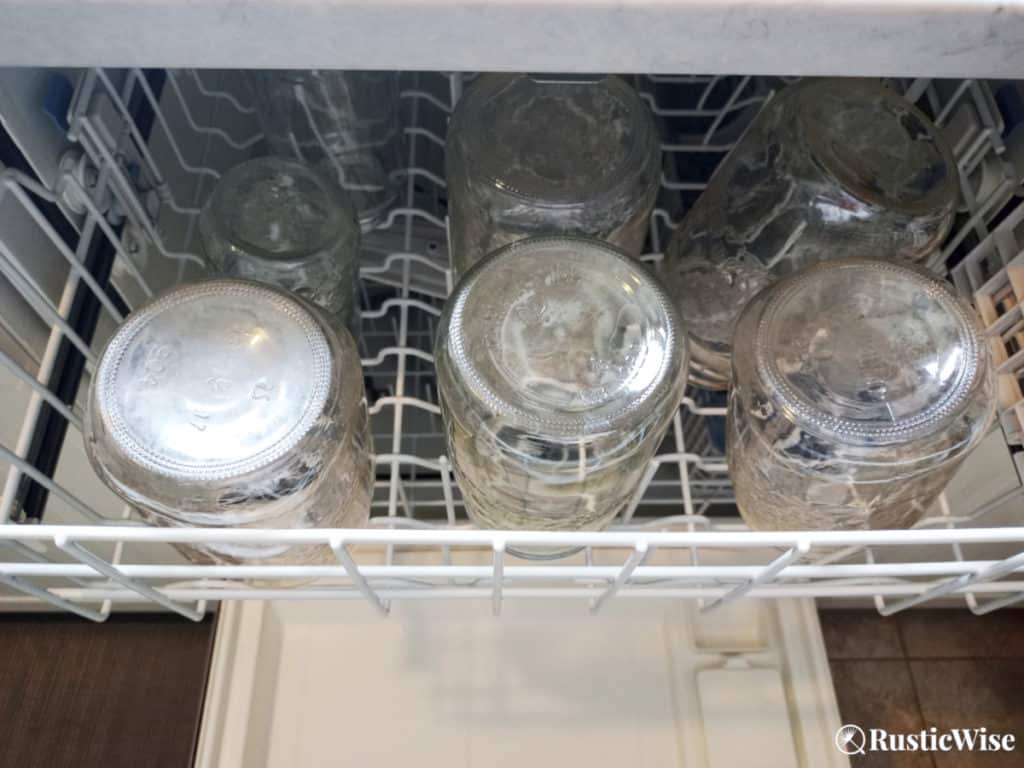
Can you sterilize canning jars in the dishwasher?
It depends on your dishwasher. To effectively sterilize (eliminate all forms of bacteria), your dishwasher needs to meet certain temperatures. Some dishwashers don’t reach a temperature high enough to sterilize jars.
Most home dishwashers reach a temperature of 130-170 degrees Fahrenheit (54-77 degrees Celsius).
NSF International (formerly the National Sanitation Foundation) states that in order to effectively kill 99.99% of bacteria, a dishwasher must reach temperatures of at least 150 degrees Fahrenheit (66 degrees Celsius) with an extended rinse.
So you see that it’s not just the temperature that matters, the length of time it’s held at this temperature also plays an important role. Some dishwashers have antibacterial settings which run for at least one hour.
To check if your dishwasher can do this, look for a NSF-certification label.
Unless you have a NSF-certified dishwasher, you may not technically be sterilizing the jars.
But using a dishwasher is a great way to sanitize jars!
Here’s how to sanitize jars in the dishwasher:
- Load up your dish racks with glass jars by placing them upside down. Try to time your wash cycle to coincide with the time you’ll be ready to can.
- Run your dishwasher on high-heat with a dry cycle.
- Leave the door closed to lock in the heat. Remove one jar at a time as needed.
Sparkling clean jars! Ensure the jars are warm before using. Keeping the jars warm until needed prevents them from shattering when filling with warm food. Avoid adding hot liquids to cold jars as this may cause the glass to shatter and break.
I know what some of you are thinking—that you’ve used the dishwasher method to clean and sanitize your jars and have never had any problems. Just be aware that while a dishwasher’s high-heat setting does a good job of heating and cleaning, it doesn’t kill all microorganisms on the glass. But, to each their own!
The boiling water method
You can safely sanitize canning jars in the dishwasher, but they’re not effectively sterilized if you’re following the guidelines by the NCHFP.
They recommend the boiling water method.
To completely sterilize jars, you need to fully submerge them in boiling water for 10 minutes (if you live in a zone of 0-1,000 feet elevation). If you live in a high-elevation area (above 1,000 feet elevation), you’ll need to add 1 extra minute per additional 1,000 feet of elevation.
To use the boiling water method to sterilize jars, place clean jars right-side-up on a canning rack in your canner or large stockpot. Fill with water so that at least 1 inch (2.5 centimeters) of water covers the tops of the jars. Bring to a boil for 10 minutes. Remove jars one at a time with a jar lifter making sure to dump back the hot water into the pot. Now you can reuse this hot water for canning!
Germs be-gone!
We’ll explore other methods people try to sanitize or sterilize jars for canning (in the oven and in the microwave) in other posts, and whether it’s safe to do so.
Do you need to boil lids and rings?
No, the consensus is that you no longer need to boil lids or rings. Boiling lids at a high temperature may cause warping which means they won’t provide a good seal. The ring bands (screw bands) don’t even come in contact with the food, so these are of lesser concern. To prep lids and rings, wash them in hot soapy water and rinse well. Then to prep them, you can use a small saucepan to bring a batch of water to a simmer until you’re ready to use them.
Some other people don’t even bother to keep the lids in a saucepan and just use clean lids at room temperature. I still like to keep them warm in a saucepan, but that’s just a personal preference.
👉 If you like this post, see our Ultimate Guide on How To Can Food. 🍎
Would you like more timeless tips via email?
Fun tips to help you live an independent, self-sustaining lifestyle. Opt-out at any time.


References:
- USDA NAL Agricultural Thesaurus and Glossary, Sterilizing, https://agclass.nal.usda.gov/mtwdk.exe?s=1&n=1&y=0&l=60&k=glossary&t=2&w=sterilizing. Accessed April 2021.
- National Center for Home Food Preservation (NCHFP), Burning Issue: Pre-Sterilizing Jars before Canning, https://nchfp.uga.edu/how/can_01/sterile_jars.html. Accessed April 2021.
- Albert Lee Appliance, FAQ About the Dishwasher Sanitize Cycle, https://www.albertlee.biz/blog/sanitize-features-in-dishwashers. Accessed April 2021.

Author: Josh Tesolin
Josh is co-founder of RusticWise. When he’s not tinkering in the garden, or fixing something around the house, you can find him working on a vast array of random side projects.

